The 429 Sqdn left from Leeming at 1943-04-14 at 15:10
He flew with a Vickers Wellington (type X, serial HZ303, code AL-).
Campaign report of the USAAF:
No report
Campaign report of the RAF:
13/14 April 1943
208 Lancasters and 3 Halifaxes bombed the dock area of La Spezia and caused heavy damage. 4 Lancasters were lost and 3 more, either damaged or in mechanical difficulty, flew on to land at Allied airfields in North Africa. It is believed that this was the first occasion that the recently captured North African airfields were used for Bomber Command aircraft in distress. The 3 Lancasters flew back to England later.
6 Mosquitos of No 105 Squadron, carried out nuisance raids to Bremen, Hamburg and Wilhelmshaven, 2 aircraft being sent to each target. These were the first non-Oboe Mosquito night raids and were the forerunners of Light Night Striking Force operations; the Germans hated the nuisance and harassing effect of the Mosquito raids and could rarely shoot down any of these fast, high-flying aircraft. The Mosquito was later modified to carry a 4,000lb bomb as far as Berlin - a favourite Mosquito target - and, in winter, individual Mosquitos were sometimes able to make 2 flights to Berlin under the cover of darkness in the same night, changing crews after the first landing.
10 Lancasters minelaying off Germany, 18 OTU sorties. 1 OTU Wellington was lost in the sea.
14/15 April 1943
462 aircraft - 146 Wellingtons, 135 Halifaxes, 98 Lancasters, 83 Stirlings - bombed Stuttgart. The Pathfinders claimed to have marked the centre of this normally difficult target accurately but the main bombing area developed to the north-east, along the line of approach of the bombing force. This was an example of the 'creepback', a feature of large raids which occurred when Main Force crews - and some Pathfinder backers-up - failed to press through to the centre of the marking area but bombed - or re-marked - the earliest markers visible. Bomber Command was never able to eliminate the creepback tendency and much bombing fell outside city areas because of it. 23 aircraft - 8 Stirlings, 8 Wellingtons, 4 Halifaxes, 3 Lancasters - lost, 5.0 per cent of the force.
With thanks to the RAF and USAAF.net!
This record can also be found on the maps of Back to Normandy with Google coordinates. You can find the maps by clicking on this link on this location.
There are several possibilities to investigate the flight records on Back to Normandy. All the flights are plotted on maps, sorted "day by day", "by squadron", "by type aircraft", "by year or month", "by location" and much more! Don't miss this!!!
If you have any information that you want to share, please add your comment at the bottom of this record. Or send your information to [email protected]. This information will be added to the record.
Your photos and your information are very welcome! The young do care and with your help we keep up the good work.



